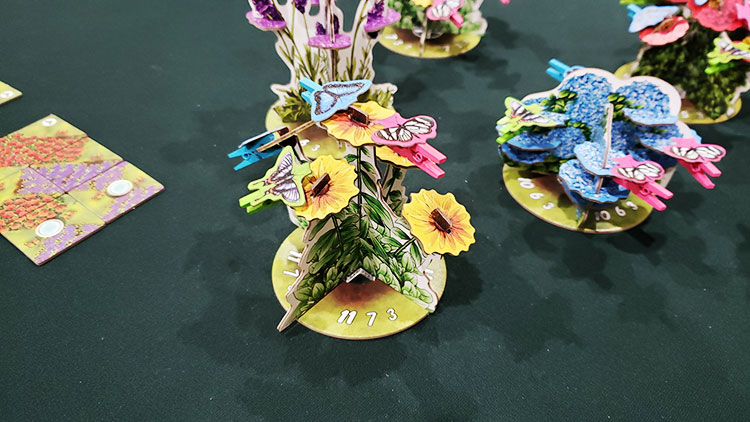 We here at Board Game Quest are organized. Even with the threatening tsunami of games that arrive on our shores, the BGQ team endures the tides of Cards Against Humanity clones to find the true pearls of board gaming. We don’t always find them though. And sometimes our expectations of greatness are dashed by a poor rulebook or undeveloped mechanisms.
We here at Board Game Quest are organized. Even with the threatening tsunami of games that arrive on our shores, the BGQ team endures the tides of Cards Against Humanity clones to find the true pearls of board gaming. We don’t always find them though. And sometimes our expectations of greatness are dashed by a poor rulebook or undeveloped mechanisms.
Rare is the case you open the box and get a 3D garden waiting to be built. That’s the case with Kolossal Games’ latest offering. Their marketing team is likely just itching to see these beauties get laid out at a convention table with eager board game Instagrammers snapping up photos. Oh, yeah, the game is Papillon (butterfly in French, looked it up), and it’s an auction, tile placement, and area control affair for 2-4 players. The box claims 30-45 minutes but really it clocks in at just under 90 minutes for four players.
Gameplay Overview:
Each player in Papillon is aiming to make a butterfly garden and send their butterflies to dominate the communal flower bushes that have sprung up on the table. One thing to note immediately from the components is that the butterflies the players use are thin cardboard tokens attached to tiny clothesline clips (clothespins). These will be carefully attached to the 3D cardboard flowers to show which butterfly is on which flower.
A round in Papillon follows 4 phases:
1. Preparation Phase: Tiles showing garden sections are placed on the main board and a gnome token is taken from the round track and added to the available pool of tiles. Players will then bid on turn order for selecting the tiles using caterpillar tokens which act as currency in the game and are also worth victory points (1 for 1) at the end.

2. Drafting Phase: The winning bidder takes tiles first and may select any row or column (see the photos). The next player in bid order does the same, but this time has a more limited selection. They could select a row or column with a missing tile, but then they’re out of 1 playing piece. This continues until all players have selected pieces.
3. Gardening Phase: Players will then simultaneously build their gardens similar to placing multiple tiles to build cities in Carcassonne. Tiles with similar garden features must be placed adjacent to each other, but the players are ultimately trying to create closed gardens of specific colors and enclosed open fields populated with the butterflies printed on the tiles.
4. Butterfly Phase: In reverse order now, players may clip butterflies on to the central flowers based on whether they created garden tile sections of 2 tiles or 3 or more tiles. For 2 tiles, the player may place 1 butterfly of their color on a flower matching the garden tile color. For 3 tiles, they do the same, but if the flower still has a bonus token, they may place an extra butterfly. This rewards enterprising players who get there first with bigger resources.
Each central flower is worth a certain number of “nectar” points at game end. For example, 8 points for first, 5 for second, 2 for third based on the number of butterflies on the flower from each player. Ties are friendly with each player scoring full points.
This phased process will repeat this process for 8 rounds. At the end, points are totaled from central flower control, largest flower groups on tiles, and caterpillar tokens remaining. The highest score is crowned Butterfly Lord and must be sprayed with ceremonial nectar. That last part might not be true.

Game Experience:
This, yes, THIS reviewer good reader did not have high hopes upon receiving Papillon. This title was expected to languish on the shelf of almost-reviewdom for a month while other more “macho” games made their way to the table of hotness. This was a mistake.
Papillon is a wonderful title. It has a common mix of already familiar elements that make a gem of a title. The tile-laying puzzle is easily complemented by the bidding for acquisition and the area majority scoring for flower control. Upon instruction, the game seems it will be pedestrian and devoid of any depth. However, the combination of mechanisms really builds upon each other. The end result is an elegantly designed whole.

Although it would be just as lovely to say the game has few flaws, it has one glaring conceit that brings down the opus. The clip-on butterflies are fiddly and prone to break (or be broken already upon first opening). More than one or two butterflies came this way and even though some simple white glue fixes it, purchasers should look out for this.
In addition, as cool as the butterflies and main flowers are to look at, they’re a pain to pin the butterflies on. It takes just enough concentration and focus that it feels rewarding when they finally get clipped on. With 4 players, this can be a headache for flowers with heavy competition.
Final Thoughts:
Papillon is more aggressive than it looks and more fun than it sounds from a descriptive blurb. It’s got a solid mix of mechanisms that build off one another while not diminishing any of them. Players can easily say they’ve seen each individual mechanism before, but rarely in this mix with this level of investment in table presence. If it wasn’t for the difficult to use butterflies with clothespins, Papillon would have been even more of a treat.
Final Score: 4 stars – Despite the sometimes clumsy veneer of fragile clip-on butterflies, Papillion is a wonderful mix of mechanisms.
 Hits:
Hits:
• Solid combination of mechanisms
• Fiercely competitive play without being mean
• Layers of strategy
Misses:
• Fiddly clip-on butterflies with main flowers























